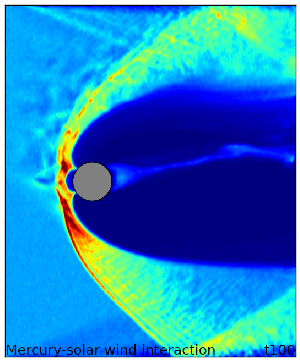Quasi-Trapped Particles in the Hermean Magnetosphere
Mercury has its own magnetic field as has been revealed by Mariner 10 in 1970's and confirmed by NASA's MESSENGER mission recently. Even if the planetary magnetic dipole strength is about 2500 times smaller, it is sufficient to form magnetosphere structure similar to the Earth's magnetosphere. Due to the minimum data from in-situ measurements, there are lot of open questions on the magnetospheric properties and processes. Global numerical simulations helps to address and answer some of them. Simulations proved useful for predictions of features to be investigated using real data and they give global context to local measurements.
Example of the solar wind to Mercury interaction simulation is shown in the animation of the proton density in Figure 1.
 Figure 1
Figure 1
One particular example of open questions is the presence of trapped particles in the inner magnetosphere. At the Earth, regions called van Allen radiation belts exist, where electrons and protons becomes trapped in the dipolar like terrestrial magnetic field. The trapped particles travels along magnetic field lines and bounce between south and north hemispheres being mirrored at the field line footprints. Further more they drift around the planet forming so called ring current. In case of Mercury it seemed to be unlikely for such region to be present, taking into account approximate ratio between the Earth's and Hermean magnetospheric scales. However global hybrid simulations suggested that at least quasi-trapped particles shall be present in the inner magnetosphere behind planet and under some conditions full plasma belt could be formed.
Figure 2 shows two examples of data sets from simulations with different external conditions. The color plots show proton density as resulted from hybrid simulations of solar wind interaction (flowing from left boundary) with an obstacle (Mercury) with its own magnetic field. White lines show traces of test particles, i.e. single proton behavior in the simulated fields. The plots are cuts from the 3D data set in the center of the planet in dawn-dusk meridian plane (left), noon-midnight meridian plane (middle) and equatorial plane (right). Top panel displays situation with northward interplanetary magnetic filed orientation (IMF). The test particle has been injected ahead of the planet at location denoted by red square. It can be seen that in this configuration the particle becomes trapped in the planetary field and drifts around the planet. Plasma particles (electrons and ions) would then form a ring current similar to the situation at the Earth. The lower panel shows simulation with southward IMF, where the result differs. At this configuration, particles cannot orbit around the whole planet, as the magnetosheath region is suppressed towards the planet. However, at the night-side, quasi-trapped particles still could be found, these either hit the planetary surface or return to the magnetosheath (as shown on the bottom panel). Presence of such quasi-trapped population has been recently confirmed by MESSENGER observations.
 Figure 2
Figure 2